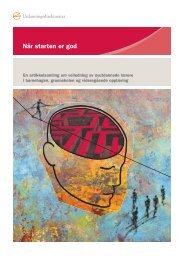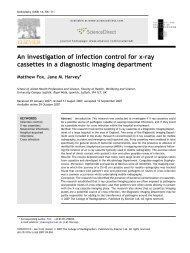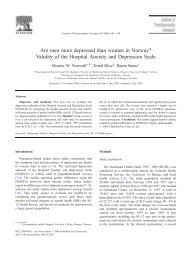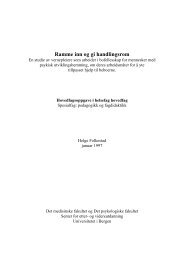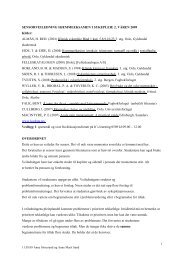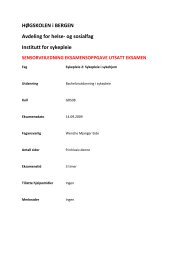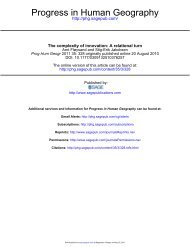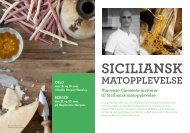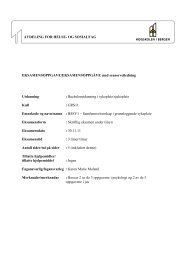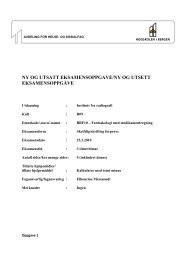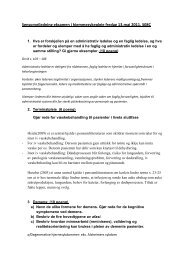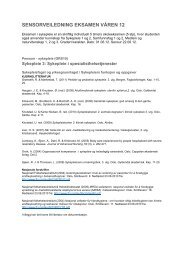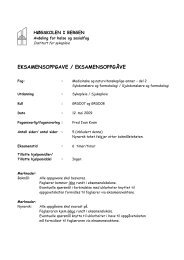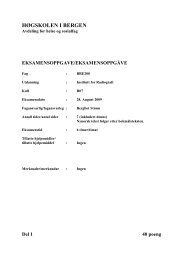Program og oversikt over posterpresentasjoner - Høgskolen i Bergen
Program og oversikt over posterpresentasjoner - Høgskolen i Bergen
Program og oversikt over posterpresentasjoner - Høgskolen i Bergen
You also want an ePaper? Increase the reach of your titles
YUMPU automatically turns print PDFs into web optimized ePapers that Google loves.
D. Studier innen idrett, kroppsøving <strong>og</strong> helse (del 1) (rom D200)<br />
Iversen V1., Wisnes, AR2., Gundersen H1and Kristoffersen, M1<br />
1Dept. Of Sport and Physical Education, <strong>Bergen</strong> University College, <strong>Bergen</strong>; Norway, 2Norwegian Sport and Olympic<br />
Federation, Norway<br />
Effects of movement specific strength training in flat water kayak paddlers<br />
Introduction: Flat water kayaking is a sport where the demands of upper body and core muscle force<br />
and force development is great in comparison to other endurance sports. (Fry and Morton, 1991;<br />
Tesch, 1983) This is mainly due to the fact that race time is relatively short and the water resistance<br />
on the boat is relatively large and increasing with the velocity. This results in the demand of high<br />
force to create and maintain speed of the boat. By this reason it is natural that a large portion of the<br />
paddlers training time is devoted to maximal strength training.<br />
The principle of specificity is central in every sport and flat water kayakers performs strength training<br />
that is as close to the real movement in a paddling stroke as possible. Imitation exercises with free<br />
weights is the most common way, but also training in a paddling apparatus which allows close to<br />
maximal strength training and at the same time resembles the specific movement (Einar model) is<br />
widely used.<br />
It is not to our knowledge been performed studies which compare traditional strength training to<br />
training in the “Einar model”.<br />
Methods: The study was approved by the Norwegian Social Science Data Services (NSD) and all<br />
participants signed an informed consent before entering the study. 16 national level flat water<br />
kayakers, 19 ± 0.0 years with an VO2 max 60.1 ± 0.0 mL∙kg-1∙min-1 participated. Two of the<br />
participants did not complete the study and their data are excluded. The participants had no<br />
previous experience with training in the “Einar model” apparatus as described in this study but well<br />
known with traditional weight training. The study was performed “post season”. All the tests were<br />
performed on the same ergometer (Dansprint, Denmark) and in “pre-season”. The software<br />
Dansprint analyzer (Dansprint, Denmark) was used to evaluate each test regard to paddling<br />
frequency, wattage, velocity, and time. Accumulated VO2 was measured during all tests, and a blood<br />
sample was taken one minute after the tests for lactate measures. Heart rate was measured using a<br />
Polar RS 800 CX, (Kempele, Finland) during the testes. Oxygen consumption was measured using a<br />
Jaeger Oxycon Pro in mixing chamber mode (Jaeger, Germany), and lactate was measured using a<br />
Lactate Scout (Biosen, Germany) device.<br />
Results and conclusion: There was no differences between groups in either of the parameters<br />
measured and the only improvement measured was a significant increase in bench press for both<br />
groups. (p



